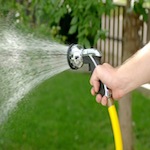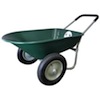Vegetable Garden Basics
There are very few things more rewarding than planning, planting, and tending your very own vegetable garden, then harvesting the delicious, nutritious vegetables (and fruits). Growing your own food is a wonderful, useful way to commune with the natural world.
As people become more concerned about how our food supply is grown (with lots of artificial chemicals) and shipped thousands of miles to our tables, do-it-yourself vegetable gardening is becoming very popular. Here are a few tips to get your garden started. Remember: gardening of any kind is a learning process. Don't be discouraged if some of your plants don't survive or produce lots of food. Learn from mistakes, and you'll soon be reaping more veggies than your family can eat!
Getting Started
Before you start digging, a little bit of planning is in order. Making sure your outdoor spaces are suitable for gardening should be your very first step. Here are a few things to check:
- Sunlight: Fruits and vegetable plants crave lots of full sunshine. Make sure your planned garden area gets at least 6 hours of full sun a day; 8 hours a day is better still.
- Soil: Vegetables need richy, loamy, well-draining soil for healthy growth. Soils in most areas will be okay, especially with added compost. Local garden centers or cooperative extension offices should have easy to use soil testing kits that will identify the type of soil you're dealing with. Read more about soil and compost HERE.
- Location, Location, Location!: Where you place your vegetable garden is important; don't plant too near to trees, shrubs, or other large plants. They'll steal nutrients the vegetable garden needs to thrive, as well as shade the garden. Keep in mind that your garden will be a tempting source of food for wild critters; placing a vegetable garden close to the house may help to keep them at bay. Again, make sure the garden gets enough sun.
Speaking of wild animals, you will probably want to fence in your garden area to protect it from critters. There's nothing more frustrating than spending hours and hours tending your garden, only to have your prized vegetables devoured by wildlife.
Raised Bed or Tilled Garden?
You also need to decide whether to have a traditional tilled garden, or use a raised bed. A raised bed will be better if you have poor soil; they allow you to create a brand-new garden area with better soil and compost than the ground provides. Raised beds are also easier to contain and protect from animals, and don't require quite so much bending since they're off the ground a bit.
Watering
As with sunshine, vegetable gardens also need lots of water for healthy growth. Requirements vary by plant, but plan on about 1 inch of water per week. Hopefully Mother Nature will cooperate and provide the majority of this moisture, but every garden at some point is going to need some irrigation. Plan on placing your garden in an area close to faucets and hoses for easy watering.
Garden Size: How Big?
If you're a beginning gardener, you may want to start small until you've gained some experience with plants. gher than that, the size of your garden really depends on how much food you want to produce; a 16' x 10' can provide food for a family of four, and isn't so big that it becomes a time-consuming task to care for.
Tools
Garden tools make gardening easier; no garden should be started without a set of basic tools: spade, fork , shovel, garden hose, and a wheelbarrow for moving stuff around. Read more HERE.
After all this planning, you're almost ready to start planning. But first, make sure you're not planting before the threat of frost is over. Frost will kill seedlings; pay attention to local weather conditions and learn what your area's first and last frost dates are. The Farmers' Almanac has a nice frost chart HERE.
What Are You Going to Grow?
What types of vegetables to grow is a highly-personal choice. If you or your family isn't likely to eat a particular vegetable, it's not worth planting. Some vegetable plants are easier to grow and care for than others, and may be a good choice for starters. Some store-bought produce can't hold a candle to homegrown veggies. If a vegetable is your favorite, and is so much more delicious when it's fresh (think tomatoes!), those are the plants you want in your garden!
A Theoretical Garden
Let's say you plan on a 16x10 ft. garden. Here is a basic, suggested planting for an 11-row plot. Thesre are vegetable plants that are most commonly grown, most popular, and best-tasting vegetables. Again, you are free to grow whatever you want; it's your garden! This is just for illustrative use only to show you what to expect out of a basic-sized garden. (information courtesy of Farmer's Almanac)
- Tomatoes (5 staked plants)
- Zucchini Squash (4 plants)
- Peppers (6 plants)
- Cabbage
- Bush Beans
- Lettuce
- Carrots
- Beets
- Radishes
- Chard
HINT: Plant marigold flowers around the perimeter of the garden and interspersed throughout. They will help keep animals (especially rabbits) out of the garden.
With a little patience, and a little practice, your garden will soon be putting more amazing vegetables on your dinner table than you would have ever imagined!
comments powered by Disqus







































































